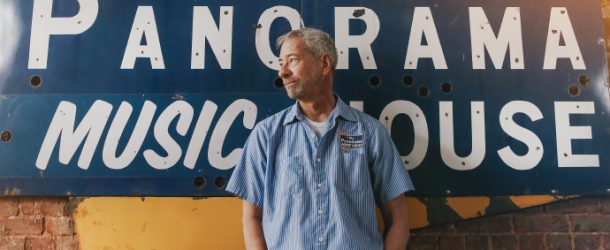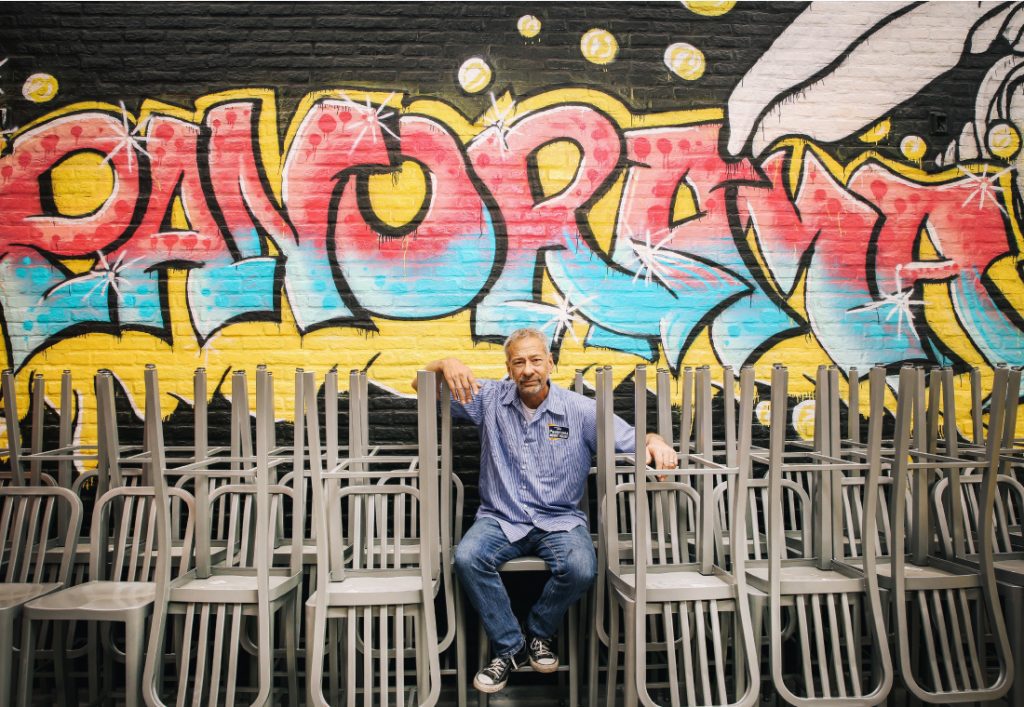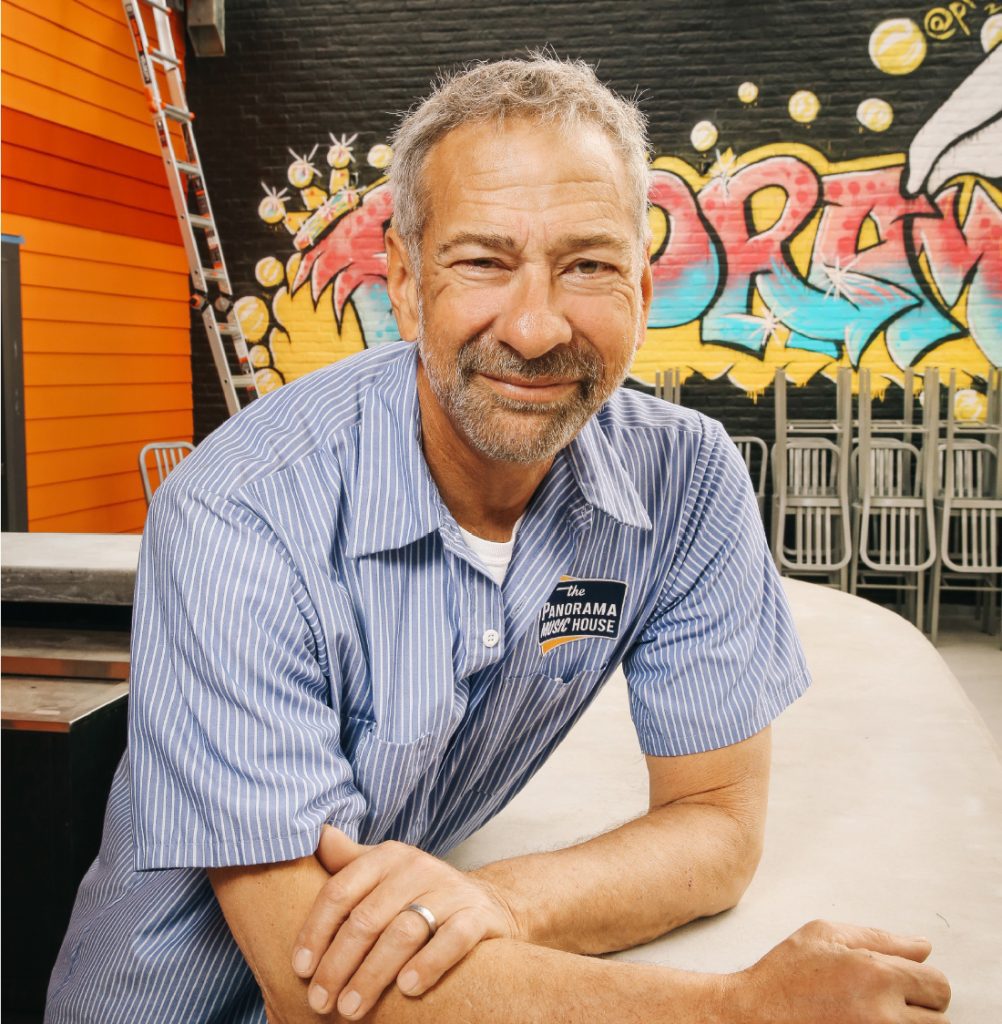As Jay Ecker Fought Cancer, He Worked To Rebuild Panorama
Story By Brad Goins ~ Photos By Chris Brennan
Even with the remodeling work not quite finished in time for this interview, the reborn Panorama Music House is a pleasure to look at. Scattered among the stacks of building supplies are art and artifacts from decades that passed long ago. If you’re alert, you may be able to spy such curiosities as a gargoyle, a foot-high model soldier in combat pose, an antique strong man “high striker” carnival game and more than one disco ball hanging from above.
In the new Panorama, there will be a strong retro vibe throughout the building. Careful observers will notice a variety of ‘70s wallpaper designs on display in one room after another.
“The decor is just stuff we’ve collected,” says Panorama owner Jay Ecker. When I asked his partner Frankie Randazzo what kind of light was hanging from the ceiling in the performance area, he said, “Free. We call it a free light.” It’s actually an enormous old Klieg light from Hollywood’s glory days. Removal of layers of old grease revealed a color like olive green.
In the new lounge that spreads out from the front entrance, a large old television will play black and white music videos (though not necessarily of musicians from the black and white era). A small, old Bakelite television sitting on top of the equally old console has the words “Panorama Music House” written on the screen. The lounge’s well-stuffed sofas and easy chairs calm the eye with stylish shades of grey.
Perhaps the most noticeable feature of the lounge is the enormous drain pipes that run under the roof. When Ecker decided to put a new rooftop bar on the floor above the lounge, he knew he had the choice of either hiding these necessary drain pipes or making them conspicuous. He chose the latter option, and painted them all a bright psychedelic green. That’s one of the reasons the lounge will be called “The Green Room.”
A New Rooftop Bar And The Upgraded Performance Area
The photograph of Lake Charles that was most widely seen in the days following Hurricane Laura was one of the enormous pile of bricks that had fallen off the exterior of the Panorama building during Hurricane Laura. Most of these came from the second floor area above the present lounge.
Ecker and his partners decided to rebuild the entire front exterior with a flat facade (in lieu of the earlier wall, which had an exterior entranceway leading to the front door).
A steel superstructure was constructed above and around the lounge to replace support previously provided by bricks. Also added was a large grey industrial garage door on the ground floor that is functional. This addition was put in place in an effort to give the front of the building a vintage firehouse look.
The large game room will continue as before in the large area to the left of the front entrance. (A number of the games came through the hurricanes in fairly good condition.)
A storm loss just as great as that of the brick wall was the destruction of the second floor Music Museum that housed the artifacts from the old Goldband Records office and studio. The museum was right behind the wall that collapsed. Few of the artifacts survived Hurricane Laura.
The repair and construction in the performance area in the right rear first floor have brought about a number of major changes. First, the layer of hardwood that was the lowest level of the ceiling has been entirely removed. Now all the exposed ceiling in the entire performance area has been covered by jet black spray-on insulation, which will vastly improve acoustics. History and architecture buffs will be pleased to know that the original joists of the ceiling are now all clearly visible. (Ecker thinks the building dates from around 1912.)
The second floor balcony bar is bordered in the front by thick black metal railing. This area will provide patrons with a good bird’s eye view of performers.
The bar moves from the balcony area straight through an exterior wall and onto the new rooftop bar. This largely open-air bar is already decorated by a wall-size Jeremy Price mural done graffiti style. In this area, patrons will be able to sit or stand next to the railing and get fine views of anything happening on Broad Street.
The bar goes through another wall and picks up in a large room immediately to the west. This area, which was previously office space, will now be used for special events. It will be the site of rotating displays of local art.
Panorama is housed in an enormous building, and surprise features and areas will be revealed as time passes. There will also be some surprises in the menu department, as new options will be served alongside old favorites.
When I interviewed Ecker, I was told that employee training was in its final stages. When it was complete and all inspectors had signed off on the venue, then Panorama would proceed immediately to a soft open. You can follow the progress on Panorama’s social media.
Once Panorama is fully online it will do business from 11 am to 2 am. Live music will be performed seven nights a week.
Fighting Cancer And The Weather
Roughly a month before Hurricane Laura hit, Ecker was diagnosed as having squamous cell cancer of the tonsils. The proposed treatment called for rounds of radiation and chemotherapy followed by surgery that would remove the tumor that grew to the left of Ecker’s tonsils.
Unfortunately, just when Ecker was ready to begin radiation and chemotherapy, the hurricane struck. The Ecker family first travelled to Little Rock, Ark., to escape the storm. Ecker went to Lafayette, where he rented a house for the family to stay in.
Ecker then began his regimen, taking the treatment five days a week. After a month, the family returned to Lake Charles, and Ecker proceeded with another two months of the regimen.
At this time, Ecker says, he was “useless” as far as attending to restaurant business went. Rikenjaks (which Ecker also owns) had done fairly well during the COVID quarantine due to its large outdoor dining area and food truck. But when Ecker was, for the most part, in his sickbed, his partners Randazzo and Buck Maraist had to deal with many of the details of the business.
Ecker was not a stranger to cancer, having beaten Hodgkin’s Disease 20 years earlier. But since Ecker’s prognosis was “unclear” after his treatments, he was still very much facing “the unknown.” The time, he says, was “pretty stressful.”
His surgery was scheduled at the M.D. Anderson Center in Houston. But the Lake Area’s capricious weather once again interfered. The day before the surgery, Lake Charles was hit by its ice storm. The surgery wound up being put off several times before a good time slot could be reserved.
“All that time, I’m really in pain,” Ecker recalls.
And the surgery, when it did take place, did not bring immediate relief. Ecker’s throat was still so swollen that surgeons were unable to intubate him. Ecker eventually learned that he had flatlined three times during the attempted surgery.
The operation was called off. Surgeons had to figure out a way to keep Ecker’s heart beating as they forced the tube through his swollen throat area. They decided on giving Ecker a temporary pacemaker.
He had to go through another week of delay as he recovered from the insertion of the pacemaker. Unfortunately, before the week ended, Ecker’s pain got “really, really bad,” and he was taken to M.D. Anderson’s emergency room.
Ecker’s surgeons had decided Ecker could not be given anesthesia until the tube had passed his throat. He’d just have to take the pain. But Ecker recalls that after the tube passed his throat, he passed out immediately. The anesthesia was timed that precisely.
Side Effects
Since that painful day, Ecker has undergone physical and speech therapy. His salivary production has dropped 80 percent. His cancer experience reduced his weight by 50 pounds. He’s gained back 30 pounds and seems more or less satisfied with that.
He still struggles to control the muscles he uses to swallow. But he remains proud of the fact that he never used a feeding tube during the entire treatment of his cancer — a very unusual approach for a patient with this sort of affliction. He must often remind himself that “you don’t have to swallow to breathe.” The goal, he says, is to teach the muscles that this is the case.
Another post-operative condition that is a challenge for Ecker is the loss of many of the nerves that ran from his neck to his left hand. It’s no longer easy for him to move his hand to the top of the acoustic bass he plays in his popular jazz ensemble. At first, his physical therapist trained him to simply move his left arm up and down over and over.
Ecker gives Memorial’s Outpatient Training department particular credit for his muscular recovery. And he’s also working with a personal trainer. “I’m in the best shape of my life because I had cancer,” says Ecker.
For a time, Ecker had to quit singing on stage. But he told me that a few days before the interview, he’d been the vocalist for a couple of songs. He said he sounded like Tom Waits.
Even with the therapy and training, some of Ecker’s side effects will be permanent.
Ecker sees an instructive parallel between his fight against cancer and his sustained push to return Panorama to working order. Both of these efforts have been exercises in transforming disaster into opportunity.
Just as he had to fight to retain control of his body, Ecker has had to wage a continuous “fight for insurance and contractors. If we had let up, we wouldn’t have gotten it done.”




















Comments are closed.